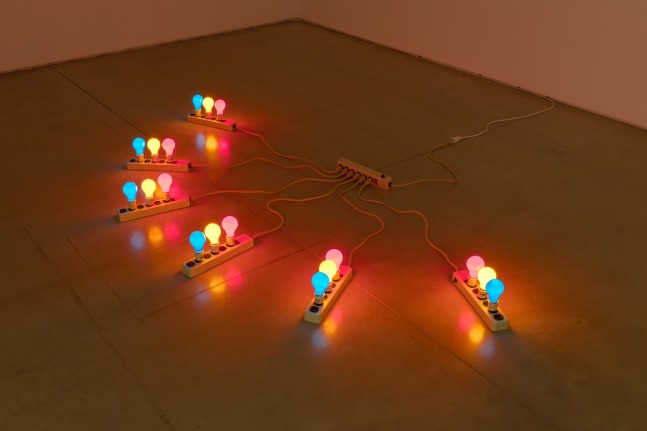
TONY FEHER
Marc Selwyn Fine Art is pleased to present Tony Feher, the gallery’s first exhibition of works by the artist.
Recognized for his subtle elegant sculptures, Feher references Minimalism yet upends the genre’s tradition through his choice of materials. His compositions employ bottles, glassware and plastic bags – the detritus of everyday life. Yet these familiar even banal objects are transformed into evocative studies of color and form. With each meticulously refined construction, the artist evokes wonder and pathos in equal measure.
Though open about the poignant sensibility in his work, Feher maintained that he was “…not trying to make things to illustrate a point or to create a specific metaphor, but if you’re successful in stripping away the identity of all these objects that you’re using, then you have the possibility of a new interpretation. There’s no need to justify the work. Its very existence is its own justification, and then you interpret it or define it from there.”
Born in 1956, Feher abandoned a career in architecture and headed to New York to establish a new professional life in 1981. Feher’s evolution as an artist coincided with the explosion of the city’s AIDs epidemic. This context had a profound effect on the artist’s oeuvre. His installations often function as memento mori and have been likened to poetry or meditation.
In a 2013 interview, the artist commented, “I’m HIV positive and I’m very fortunate that the pharmaceuticals that keep you alive came online right when I needed them. A good friend of mine missed that window; he would be alive today had those drugs arrived only a few months earlier. That’s the climate that we were all living in during the late ’80s early ’90s…That certainly has a profound effect on how you think and how you look at the world.”
This exhibition comprises thirteen works created between 2000-2015. Included are floor and hanging sculptures, an electric light work and an example from one of his critically acclaimed series, Laying Between Green and Violet. These artworks feature materials extracted from the artist’s New York City environment such as depression glass, light bulbs, tape, rods, marbles and plastic water bottles.
In Laying Between Green and Violet #5, 2015, the artist’s investigation of light and color employs blue painter’s tape. Inspired by the light falling through a window masked off to be painted, Feher utilizes this commonplace jobsite technique and material to conjure the look and feel of stained glass – complete with all of stained glass’ meditative qualities intact. Untitled, 2000 features six groups of lightbulbs in primary colors – blue, red, and yellow. Each bulb flickers in different combinations at different speeds. As per the dictates of color theory, these combinations create secondary colors. Suddenly, there is an allusion to a full spectrum of visual possibilities born of the same flickering light one might find outside a convenience mart.
Not unlike Felix Gonzalez-Torres’s more overtly intellectual work, Feher’s sculptures capture the way that, much like human life, his materials couldn’t last forever. Yet, while acknowledging the finite lifespan of his artwork, the artist commented, “When you strip things bare, you allow them to take on the possibility of a broader meaning. Reduction opens them up.”
Tony Feher (b. 1956, Albuquerque, New Mexico; d. 2016, New York City) was raised in Corpus Christi, Texas, with time spent in Florida and Virginia. He received a BA in Architecture from the University of Texas at Austin in 1978 and worked for architects in Texas before moving to New York City in 1981. Feher presented his first solo exhibition at Wooster Gardens in New York in 1993 and went on to have over forty solo shows at galleries and institutions. Notable presentations include the Hammer Museum in Los Angeles; the Hessel Museum of Art at the Center for Curatorial Studies, Bard College; the Bronx Museum of the Arts; a mid-career survey organized by Claudia Schmuckli that opened at the Des Moines Art Center, Iowa, in 2012 and traveled to Houston’s Blaffer Art Museum and the deCordova Sculpture Park and Museum in Lincoln, Massachusetts. Additionally, his work is included in the permanent collections of the Solomon R. Guggenheim Museum, the Whitney Museum of American Art in New York; the Hessel Museum of Art at CCS Bard in Annandale-on-Hudson, New York; the San Francisco Museum of Modern Art; and the Art Institute of Chicago.